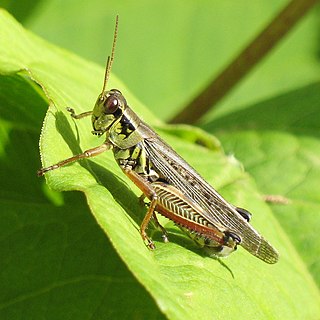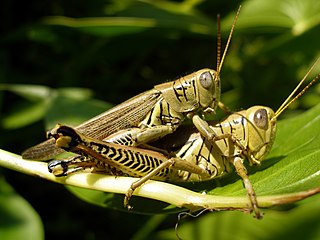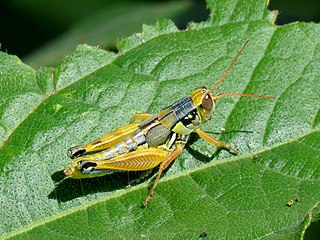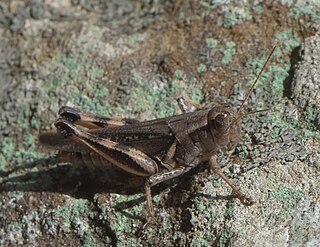
The Rocky Mountain locust is an extinct species of grasshopper that ranged through the western half of the United States and some western portions of Canada with large numbers seen until the end of the 19th century. Sightings often placed their swarms in numbers far larger than any other locust species, with one famous sighting in 1875 estimated at 198,000 square miles (510,000 km2) in size, weighing 27.5 million tons and consisting of some 12.5 trillion insects, the greatest concentration of animals ever speculatively guessed, according to Guinness World Records.

Melanoplus is a large genus of grasshoppers. They are the typical large grasshoppers in North America. A common name is spur-throat grasshoppers, but this more typically refers to members of the related subfamily Catantopinae.

The differential grasshopper is a species of grasshopper belonging to the genus Melanoplus. It is found throughout northern Mexico, the central United States and southern Ontario, Canada. It is considered a pest over most of its range.

Melanoplus bivittatus, the two-striped grasshopper, is a poikilothermic species of grasshopper belonging to the genus Melanoplus. It is commonly found in North America, with high quantities inhabiting Canadian prairies and farmland.

Melanoplus femurrubrum, the red-legged grasshopper, is a species of grasshopper belonging to the genus Melanoplus. It is one of the most common grasshoppers found in Mexico, the United States, and Canada. This grasshopper is frequently used as a model organism in scientific studies, due to their abundance throughout North America and behavioral response to changes in climate.

Melanoplus lakinus, the lakin grasshopper, is a species of spur-throated grasshopper in the family Acrididae. It is found in North America.
Melanoplus alpinus, known generally as the Alpine grasshopper or Alpine spur-throat grasshopper, is a species of spur-throated grasshopper in the family Acrididae. It is found in North America.

Melanoplus sanguinipes, known generally as migratory grasshopper, is a species of spur-throated grasshopper in the family Acrididae. Other common names include the lesser migratory grasshopper and red-legged grasshopper. It is found in the Caribbean and North America.
Melanoplus franciscanus, the San Francisco short-wing grasshopper, is a species of spur-throated grasshopper in the family Acrididae. It is found in the American Southwest, in the Guadalupe Mountains of Texas and from the San Mateo Mountains of New Mexico to the San Francisco Peaks of Arizona. .

Melanoplus aridus, the arid lands spur-throat grasshopper, is a species of spur-throated grasshopper in the family Acrididae. It is found in North America.

Melanoplus punctulatus, known generally as the pine tree spur-throat grasshopper or grizzly spur-throat grasshopper, is a species of spur-throated grasshopper in the family Acrididae. It is found in North America.

Melanoplus keeleri, commonly known as Keeler's spur-throat grasshopper or Keeler grasshopper, is a species of spur-throated grasshopper in the family Acrididae. It is found in North America.

Melanoplus scudderi, or Scudder's short-wing grasshopper, is a species of spur-throated grasshopper in the family Acrididae. It is found in North America.

Melanoplus foedus, the striped sand grasshopper, is a species of spur-throated grasshopper in the family Acrididae. It is found in North America.

Melanoplus devastator, the devastating grasshopper, is a species of spur-throated grasshopper in the family Acrididae. It is found in North America.
Melanoplus bruneri, known generally as the Bruner's spur-throat grasshopper or Bruner's locust, is a species of spur-throated grasshopper in the family Acrididae. It is found in North America.
Catorhintha viridipes is a species of leaf-footed bug in the family Coreidae. It is found in the Caribbean Sea, North America, and the Caribbean.

Hypochlora alba, known generally as mugwort grasshopper, is a species of spur-throated grasshopper in the family Acrididae. Other common names include the sage grasshopper and cudweed grasshopper. It is found in North America. It feeds exclusively on Artemisia ludoviciana.

Oxyderces viridipes is a species of broad-nosed weevils in the family Curculionidae. This species is endemic to Colombia, commonly found in Medellín and surrounding areas, but has been incidentally collected in the United States.














